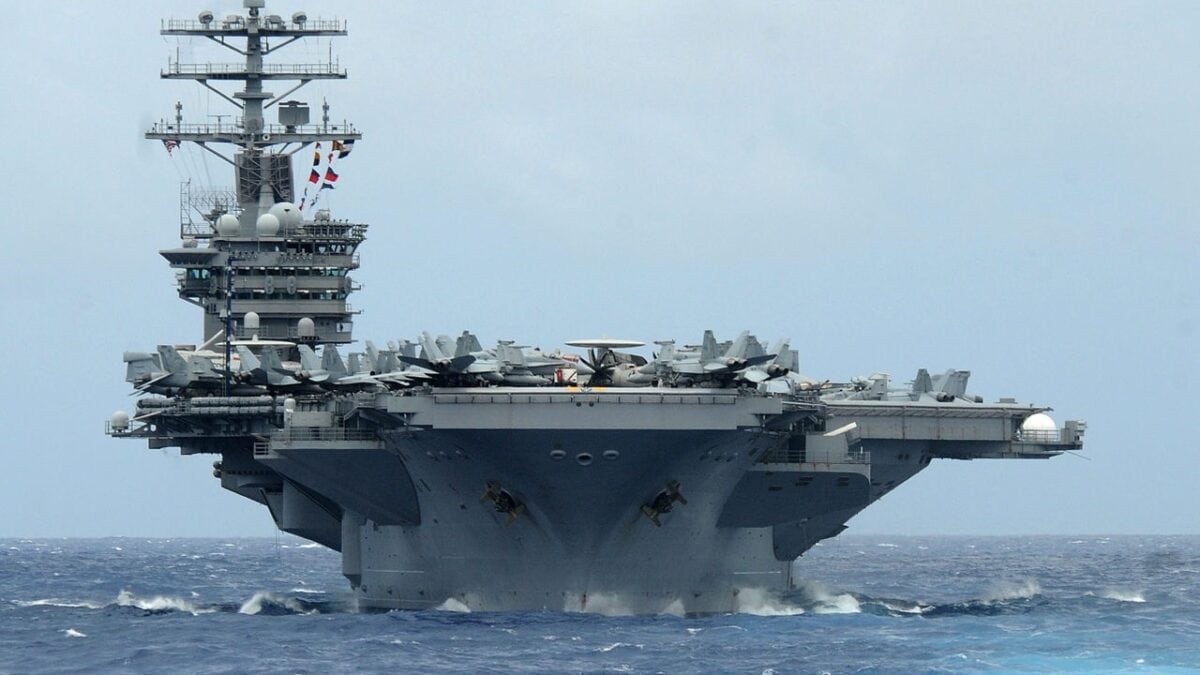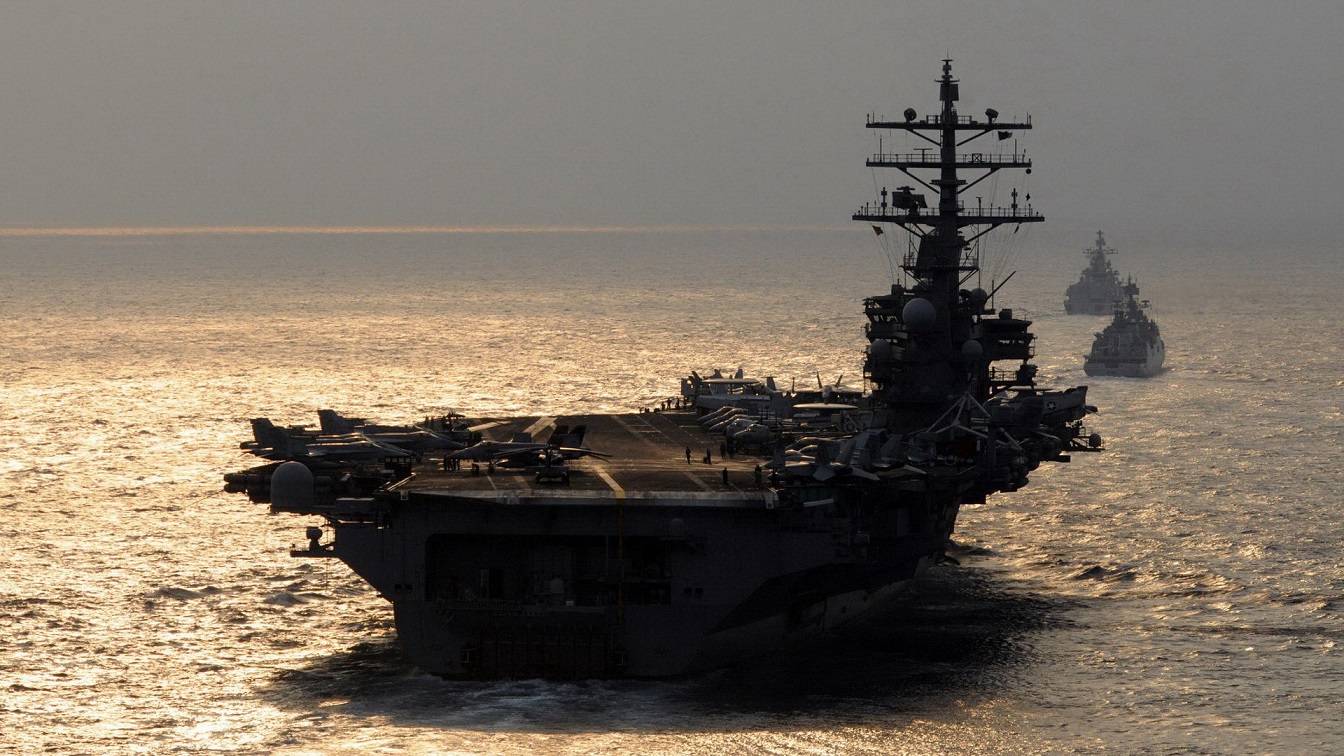Why are U.S. Navy Aircraft Carriers suffering from drinking water issues? Many a sailor is likely familiar with the Rime of the Ancient Mariner, which proclaims, “water, water, everywhere, nor any drop to drink.” For some U.S. sailors, it isn’t just the water surrounding their vessel that isn’t fit for human consumption, but the not-so-fresh drinking water aboard ship.

The aircraft carrier USS George Washington sails through calm seas near Guam at sunset while under way in the Pacific Ocean, Sept. 8, 2012. The George Washington is the centerpiece of Carrier Strike Group 5, the US Navy’s only continuously forward deployed carrier strike group, based out of Yokosuka, Japan. Carrier Strike Group 5 is currently on a routine Western Pacific patrol.
The United States Navy has been investigating what caused the potable water aboard USS Abraham Lincoln (CVN-72) to be “rank and cloudy” last month. Sailors who drank the water had reportedly become sick, and the Navy said that traces of bacteria were found in the water. It has confirmed that the E. coli was what had been detected.
The Nimitz-class carrier had returned to Naval Base Coronado, San Diego last week following a two-week mission off the coast of Southern California. It was during the brief deployment that sailors first noted that something was wrong with the water. One sailor, who spoke with local news, said she drank the water on the ship and got sick, vomiting daily for several days.
Efforts have been made to address the issue, which appeared to impact three potable water tanks – which were immediately isolated and secured from the ship’s water system. The odor and cloudiness in the ship’s water had abated by the next day.
“USS Abraham Lincoln (CVN-72) found traces of bacteria in the ship’s potable water while operating off the coast of southern California on September 21. The crew shifted water tanks to isolate the affected water. All tanks providing water to the crew have been tested and are bacteria-free. The crew has safe water to drink. There have been no confirmed cases of illness related to the ship’s water. The health and wellbeing of our Sailors is a top priority,” said Cmdr. Sean Robertson, spokesperson for the U.S. 3rd Fleet, via a statement to the media.
The issue is unlikely to impact the planned college basketball game that is scheduled to be played on the carrier’s flight deck on Veteran’s Day, November 11 between Gonzaga and Michigan State University. It is the first game to be played on an active duty aircraft carrier in San Diego since the Veteran’s Day match-up between MSU and North Carolina University aboard USS Carl Vinson (CVN-70) – while San Diego State University played Syracuse University on the deck of the USS Midway Museum in 2012.
Most Recent Aircraft Carrier to Have a Water Crisis
It wasn’t just CVN-72 that had an issue with its drinking water, and the U.S. Navy’s problems with potable water seem to be as great as anything in Flint, Michigan, or Jackson, Mississippi. It wasn’t E. coli, but rather traces of jet fuel that were found in the water used to bathe and drink aboard USS Nimitz (CVN-68).
Sailors have expressed concerns that they may have been exposed to an “unhealthy amount of JP-5,” a military jet fuel primarily used on aircraft carriers. It is noted for being a high flash point kerosene that meets the requirements of the U.S. Military Specification MIL-PRF-5624S Grade JP-5.
The carrier, the lead and oldest vessel of the Navy’s Nimitz-class of nuclear-powered supercarriers, was forced to return to port to deal with the issue last month.

PHILIPPINE SEA (Feb. 28, 2022) Aviation Boatswain’s Mate (Equipment) 3rd Class Anatalia Zamora, from Midland, Texas, runs to a safe distance before an F/A-18E Super Hornet assigned to the “Tophatters” of Strike Fighter Squadron (VFA) 14 launches from the flight deck of the Nimitz-class aircraft carrier USS Abraham Lincoln (CVN 72). The Abraham Lincoln Carrier Strike Group is on a scheduled deployment in the U.S. 7th Fleet area of operations to enhance interoperability through alliances and partnerships while serving as a ready-response force in support of a free and open Indo-Pacific region. (U.S. Navy photo by Mass Communication Specialist 3rd Class Michael Singley) 220228-N-MM912-1137

PACIFIC OCEAN (July 18, 2012) The aircraft carrier USS Nimitz (CVN 68) is underway during the Great Green Fleet demonstration portion of the Rim of the Pacific (RIMPAC) 2012 exercise. Nimitz took on 200,000 gallons of biofuel in preparation for the Great Green Fleet demonstration during Rim of the Pacific (RIMPAC) 2012. Twenty-two nations, more than 40 ships and submarines, more than 200 aircraft and 25,000 personnel are participating in RIMPAC exercise from June 29 to Aug. 3, in and around the Hawaiian Islands. The world’s largest international maritime exercise, RIMPAC provides a unique training opportunity that helps participants foster and sustain the cooperative relationships that are critical to ensuring the safety of sea lanes and security on the world’s oceans. RIMPAC 2012 is the 23rd exercise in the series that began in 1971. (U.S. Navy photo by Mass Communication Specialist 2nd Class Eva-Marie Ramsaran/Released)
“Nimitz got underway after all tests came back in limits and the potable water was determined to be safe for the crew,” Cmdr. Robertson, said in another statement to USNI News. “The ship had been pier side at Naval Air Station North Island since Sept. 17 flushing, cleaning, testing and evaluating its potable water system to ensure the highest quality water is provided to the crew after trace amounts of jet-propellant 5 (JP-5) were found in its potable water system Sept. 16 while underway off the coast of California.”
The Navy also announced that during her time back in port, the carrier hooked up to San Diego water and flushed the system with about one million gallons of fresh water.
A Senior Editor for 1945, Peter Suciu is a Michigan-based writer who has contributed to more than four dozen magazines, newspapers, and websites with over 3,000 published pieces over a twenty-year career in journalism. He regularly writes about military hardware, firearms history, cybersecurity, and international affairs. Peter is also a Contributing Writer for Forbes. You can follow him on Twitter: @PeterSuciu.

